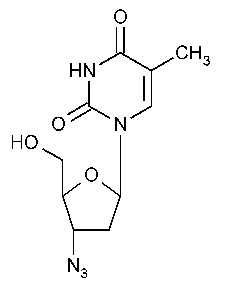Zidovudine
»Zidovudine contains not less than 97.0percent and not more than 102.0percent of C10H13N5O4,calculated on the anhydrous basis.
Packaging and storage—
Preserve in tight,light-resistant containers.Store at 25 ,excursions permitted between 15
,excursions permitted between 15 and 30
and 30 .
.
USP Reference standards á11ñ—
USP Zidovudine RS.USP Zidovudine Related Compound B RS.USP Zidovudine Related Compound C RS.
Identification—
A:
Infrared Absorption á197Kñ.
B:
The retention time of the major peak in the chromatogram of the Assay preparationcorresponds to that in the chromatogram of the Standard preparation,as obtained in the Assay.
Specific rotation á781Sñ:
between +60.5 and +63
and +63 .
.
Test solution:
10mg per mL,in alcohol.
Water,Method Iá921ñ:
not more than 1.0%.
Residue on ignition á281ñ:
not more than 0.25%.
Chromatographic purity—
TEST A—
Standard solution—
Dissolve accurately weighed quantities of USP Zidovudine RS,and triphenylmethanol in methanol,and mix to obtain a solution having known concentrations of about 0.1mg of each per mL.
Test solution—
Dissolve an accurately weighed quantity of Zidovudine in methanol to obtain a solution containing 20mg per mL.
Procedure—
Separately apply 10µLof the Test solutionand 10µLof the Standard solutionto a thin-layer chromatographic plate (see Chromatography á621ñ)coated with a 0.25-mm layer of chromatographic silica gel mixture containing a fluorescent indicator having an optimal intensity at 254nm.Develop the chromatogram in a solvent system consisting of chloroform and methanol (9:1)until the solvent front has moved about three-fourths of the length of the plate.Remove the plate from the chamber,mark the solvent front,and allow the solvent to evaporate.Examine the plate under short-wavelength UVlight,and compare the intensities of any secondary spots observed in the chromatogram of the Test solutionwith those of the principal spot in the chromatogram of the Standard solution:no secondary spot from the chromatogram of the Test solutionis larger or more intense than the principal spot obtained from the Standard solution,and the sum of the intensities of the secondary spots obtained from the Test solutioncorresponds to not more than 3.0%.Spray the plate with a mixture of 0.5g of carbazole in 95mLof alcohol and 5mLof sulfuric acid,heat for 10minutes at 120 ,and compare the intensities of any secondary spots observed in the chromatogram of the Test solutionwith those of the principal spots in the chromatogram of the Standard solution:no spot corresponding to triphenylmethanol (RFvalue about 2.3relative to the RFvalue of zidovudine)is more intense than the corresponding spot from the Standard solution,no secondary spot from the chromatogram of the Test solutionis larger or more intense than the principal spot obtained from the Standard solution,and the sum of the intensities of the secondary spots obtained from the Test solutioncorresponds to not more than 3.0%.
,and compare the intensities of any secondary spots observed in the chromatogram of the Test solutionwith those of the principal spots in the chromatogram of the Standard solution:no spot corresponding to triphenylmethanol (RFvalue about 2.3relative to the RFvalue of zidovudine)is more intense than the corresponding spot from the Standard solution,no secondary spot from the chromatogram of the Test solutionis larger or more intense than the principal spot obtained from the Standard solution,and the sum of the intensities of the secondary spots obtained from the Test solutioncorresponds to not more than 3.0%.
TEST B—
Proceed as directed in the Assay,using the Assay preparationas the test solution.Calculate the percentage of each impurity in the portion of Zidovudine taken by the formula:
100(ri/rs),
in which riis the peak response for each impurity,and rsis the sum of the responses of all of the peaks:not more than 1.0%of zidovudine related compound Band not more than 2.0%of zidovudine related compound Care found,and the sum of all impurities from Test Aand Test Bis not more than 3.0%.
Organic volatile impurities,Method Vá467ñ:
meets the requirements.
Solvent—
Use dimethyl sulfoxide.
Assay—
Mobile phase—
Prepare a filtered and degassed mixture of water and methanol (80:20).Make adjustments if necessary (see System Suitabilityunder Chromatography á621ñ).
Standard stock solution—
Dissolve an accurately weighed quantity of USP Zidovudine RSin methanol,and dilute quantitatively,and stepwise if necessary,with methanol to obtain a solution having a known concentration of about 1.0mg per mL.
Zidovudine related compound Bstandard stock solution—
Dissolve an accurately weighed quantity of USP Zidovudine Related Compound B RSin methanol,and dilute quantitatively,and stepwise if necessary,with methanol to obtain a solution having a known concentration of about 0.1mg per mL.
Zidovudine related compound Cstandard stock solution—
Transfer about 20mg of USP Zidovudine Related Compound C RS,accurately weighed,to a 100-mLvolumetric flask,add 75mLof methanol,sonicate for 15minutes,dilute with methanol to volume,and mix.
Standard preparation—
Transfer 10.0mLof Standard stock solution,1.0mLof Zidovudine related compound Bstandard stock solution,and 1.0mLof Zidovudine related compound Cstandard stock solutionto a 100-mLvolumetric flask,dilute with methanol to volume,and mix.
Assay preparation—
Transfer about 100mg of Zidovudine,accurately weighed,to a 100-mLvolumetric flask,dissolve in and dilute with methanol to volume,and mix.Transfer 10.0mLof this solution to a 100-mLvolumetric flask,dilute with methanol to volume,and mix.
Chromatographic system(see Chromatography á621ñ)—
The liquid chromatograph is equipped with a 265-nm detector and a 4.0-mm ×25-cm column that contains packing L1and a 3.2-mm ×1.5-cm guard column containing packing L1.The flow rate is about 1.0mLper minute.Chromatograph the Standard preparation,and record the peak responses as directed for Procedure:the relative retention times are about 0.25for zidovudine related compound C(thymine),1.0for zidovudine,and 1.17for zidovudine related compound B(3¢-chloro-3¢-deoxythymidine);the resolution,R,between zidovudine and zidovudine related compound Bis not less than 1.4;the tailing factor is not more than 1.5;and the relative standard deviation for replicate injections is not more than 2.0%.
Procedure—
Separately inject equal volumes (about 10µL)of the Standard preparationand the Assay preparationinto the chromatograph,record the chromatograms,and measure the responses for the major peaks.Calculate the quantity,in mg,of C10H13N5O4in the portion of Zidovudine taken by the formula:
1000C(rU/rS),
in which Cis the concentration,in mg per mL,of USP Zidovudine RSin the Standard preparation;and rUand rSare the peak responses obtained from the Assay preparationand the Standard preparation,respectively.
Auxiliary Information—
Staff Liaison:Behnam Davani,Ph.D.,MBA,Senior Scientist
Expert Committee:(PA7)Pharmaceutical Analysis 7
USP28–NF23Page 2047
Pharmacopeial Forum:Volume No.29(6)Page 2006
Phone Number:1-301-816-8394
